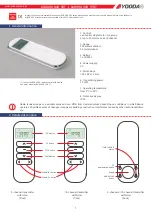
627-500
31
COMPONENTS
S & C P M X Mo d u l a r Me t a l - E n c l o s e d S w i t c h ge a r
incorporates S&C’s fi eld-proven components for switching
and protection of high-voltage power distribution circuits.
These components, which are available in a variety of
combinations to meet system requirements, are briefl y
described below. For complete instructions on these
components, refer to the applicable S&C instruction sheets
in the instruction manual furnished with each assembly of
PMX Switchgear. The information that follows is provided
for preliminary familiarization with these components.
Mini-Rupter Switch
The S&C Mini-Rupter Switch is a three-pole group-operated
interrupter switch. It is applied in PMX Switchgear for
switching loads of up to 600 continuous amperes at 13.8 kV
and 25 kV. Mini-Rupters used in PMX Switchgear include
a quick-make, quick-break mechanism integrally mounted
on the switch frame. Instructions for operation of these
switches are contained in the S&C instruction sheets for
S&C Mini-Rupter Switches.
Power Fuses
S&C Power Fuses—Types SM-4Z, SM-5S, SM-20, and
SM-40, as well as Fault Fiter® Electronic Power Fuses are
available in PMX Switchgear with live-front construction,
in combination with an S&C Mini-Rupter Switch. S&C
Power Fuses—Types SME-4Z, SME-20, and SME-40, as
well as Fault Fiter Electronic Power Fuses are available in
PMX Switchgear with enhanced fuse handling construction
in combination with an S&C Mini-Rupter Switch.
Each S&C Power Fuse is equipped with a blown-
fuse target, permitting positive visual check of fuse
condition without removing the fuse from its mounting.
For instructions on installation and operation of fuses,
and how to detect a blown fuse, refer to the instruction
sheet for the fuse type furnished. For instructions on
installation and replacement of refi ll units, fuse units, or
interrupting modules, refer to the S&C instruction sheet
included with each refi ll unit, fuse unit, or interrupting
module, as applicable.
Switch Operator—Type PM
Type PM Switch Operators permit power operation of Mini-
Rupter Switches in response to opening and closing signals
initiated from a remote location. All Type PM Switch
Operators include an integral motor for power operating
the quick-make, quick-break mechanism of the Mini-Rupter
Switch (switch operation is achieved in approximately 3
seconds with nominal control voltage); open/close push
buttons for local electrical operation; provisions for local
manual operation;a local/remote selector switch that
permits local operation when in the “LOCAL” position,
while preventing remote operation; auxiliary-switch
contacts for remote indication of the switch position;
a decoupler to permit operation of the switch operator
without affecting the position of the switch; an operation
counter; and S&C Penta-Latch Mechanism on the door for
access control to the interior of the switch operator.
The Penta-Latch Mechanism provides automatic door
latching and permits padlocking only when the door is
securely latched. The door can be opened only with a
pentahead socket wrench or tool. A storage bracket is
included for holding the manual operating handle. The
handle permits local manual charging and tripping of the
quick-make quick-break mechanism in the event control
power is not available.
Micro-AT
®
Source-Transfer Control
An S&C Micro-AT Source-Transfer Controls is used in PMX
Switchgear, in conjunction with S&C Mini-Rupter Switches,
to provide automatic source transfer for primary-selective
systems. This solid-state electronic device includes
fi eld-programmable operating-mode selector switches,
timer adjustment dials, and test switches. The control
is pre-engineered to provide a particular level of source-
transfer automation. Monitoring inputs for the Micro-AT
Control are typically supplied from each source by three
S&C Voltage Sensors. An adjustable burden-resistor
assembly, containing secondary burdens for S&C Voltage
Sensors and/or secondary fuses for voltage transformers,
is an integral part of the Micro-AT Control. Instructions
foroperation and adjustment of the source-transfer control
and the adjustable burden-resistor assembly are contained
in the S&C instruction sheets for the S&C Micro-AT Source-
Transfer Control.







































